fuel LINCOLN CONTINENTAL 2020 Owners Manual
[x] Cancel search | Manufacturer: LINCOLN, Model Year: 2020, Model line: CONTINENTAL, Model: LINCOLN CONTINENTAL 2020Pages: 609, PDF Size: 6.24 MB
Page 6 of 609
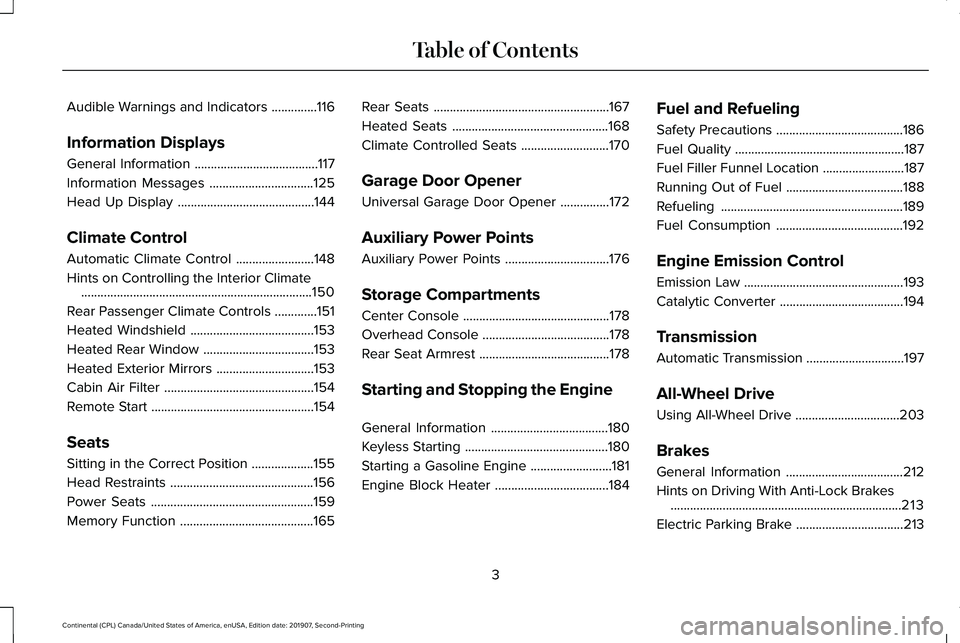
Audible Warnings and Indicators
..............116
Information Displays
General Information ......................................
117
Information Messages ................................
125
Head Up Display ..........................................
144
Climate Control
Automatic Climate Control ........................
148
Hints on Controlling the Interior Climate .......................................................................
150
Rear Passenger Climate Controls .............
151
Heated Windshield ......................................
153
Heated Rear Window ..................................
153
Heated Exterior Mirrors ..............................
153
Cabin Air Filter ..............................................
154
Remote Start ..................................................
154
Seats
Sitting in the Correct Position ...................
155
Head Restraints ............................................
156
Power Seats ..................................................
159
Memory Function .........................................
165Rear Seats
......................................................
167
Heated Seats ................................................
168
Climate Controlled Seats ...........................
170
Garage Door Opener
Universal Garage Door Opener ...............
172
Auxiliary Power Points
Auxiliary Power Points ................................
176
Storage Compartments
Center Console .............................................
178
Overhead Console .......................................
178
Rear Seat Armrest ........................................
178
Starting and Stopping the Engine
General Information ....................................
180
Keyless Starting ............................................
180
Starting a Gasoline Engine .........................
181
Engine Block Heater ...................................
184Fuel and Refueling
Safety Precautions
.......................................
186
Fuel Quality ....................................................
187
Fuel Filler Funnel Location .........................
187
Running Out of Fuel ....................................
188
Refueling ........................................................
189
Fuel Consumption .......................................
192
Engine Emission Control
Emission Law .................................................
193
Catalytic Converter ......................................
194
Transmission
Automatic Transmission ..............................
197
All-Wheel Drive
Using All-Wheel Drive ................................
203
Brakes
General Information ....................................
212
Hints on Driving With Anti-Lock Brakes .......................................................................
213
Electric Parking Brake .................................
213
3
Continental (CPL) Canada/United States of America, enUSA, Edition date: 201907, Second-Printing Table of Contents
Page 7 of 609
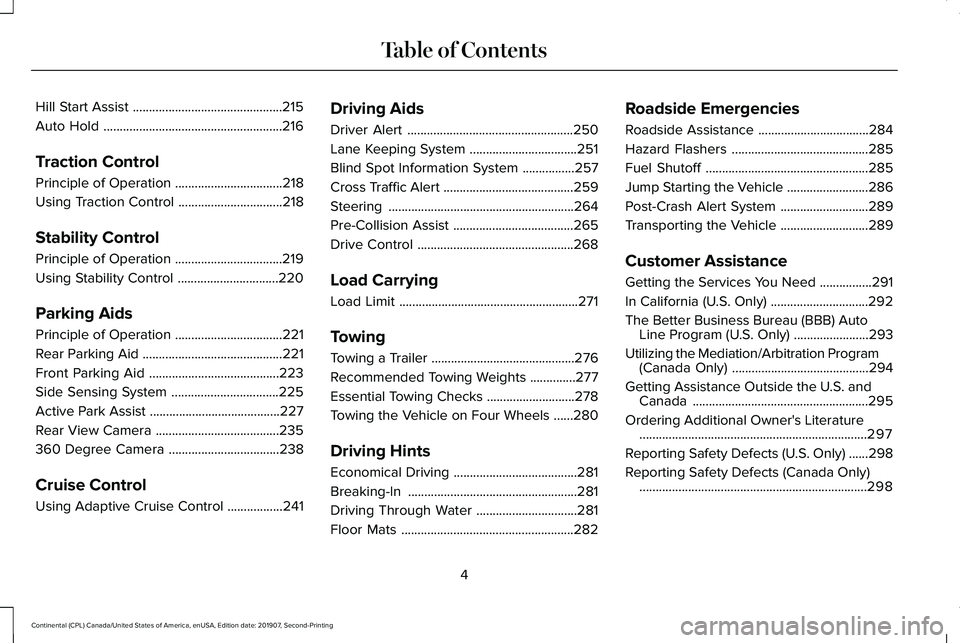
Hill Start Assist
..............................................215
Auto Hold .......................................................
216
Traction Control
Principle of Operation .................................
218
Using Traction Control ................................
218
Stability Control
Principle of Operation .................................
219
Using Stability Control ...............................
220
Parking Aids
Principle of Operation .................................
221
Rear Parking Aid ...........................................
221
Front Parking Aid ........................................
223
Side Sensing System .................................
225
Active Park Assist ........................................
227
Rear View Camera ......................................
235
360 Degree Camera ..................................
238
Cruise Control
Using Adaptive Cruise Control .................
241Driving Aids
Driver Alert
...................................................
250
Lane Keeping System .................................
251
Blind Spot Information System ................
257
Cross Traffic Alert ........................................
259
Steering .........................................................
264
Pre-Collision Assist .....................................
265
Drive Control ................................................
268
Load Carrying
Load Limit .......................................................
271
Towing
Towing a Trailer ............................................
276
Recommended Towing Weights ..............
277
Essential Towing Checks ...........................
278
Towing the Vehicle on Four Wheels ......
280
Driving Hints
Economical Driving ......................................
281
Breaking-In ....................................................
281
Driving Through Water ...............................
281
Floor Mats .....................................................
282Roadside Emergencies
Roadside Assistance
..................................
284
Hazard Flashers ..........................................
285
Fuel Shutoff ..................................................
285
Jump Starting the Vehicle .........................
286
Post-Crash Alert System ...........................
289
Transporting the Vehicle ...........................
289
Customer Assistance
Getting the Services You Need ................
291
In California (U.S. Only) ..............................
292
The Better Business Bureau (BBB) Auto Line Program (U.S. Only) .......................
293
Utilizing the Mediation/Arbitration Program (Canada Only) ..........................................
294
Getting Assistance Outside the U.S. and Canada ......................................................
295
Ordering Additional Owner's Literature ......................................................................
297
Reporting Safety Defects (U.S. Only) ......
298
Reporting Safety Defects (Canada Only) ......................................................................
298
4
Continental (CPL) Canada/United States of America, enUSA, Edition date: 201907, Second-Printing Table of Contents
Page 8 of 609
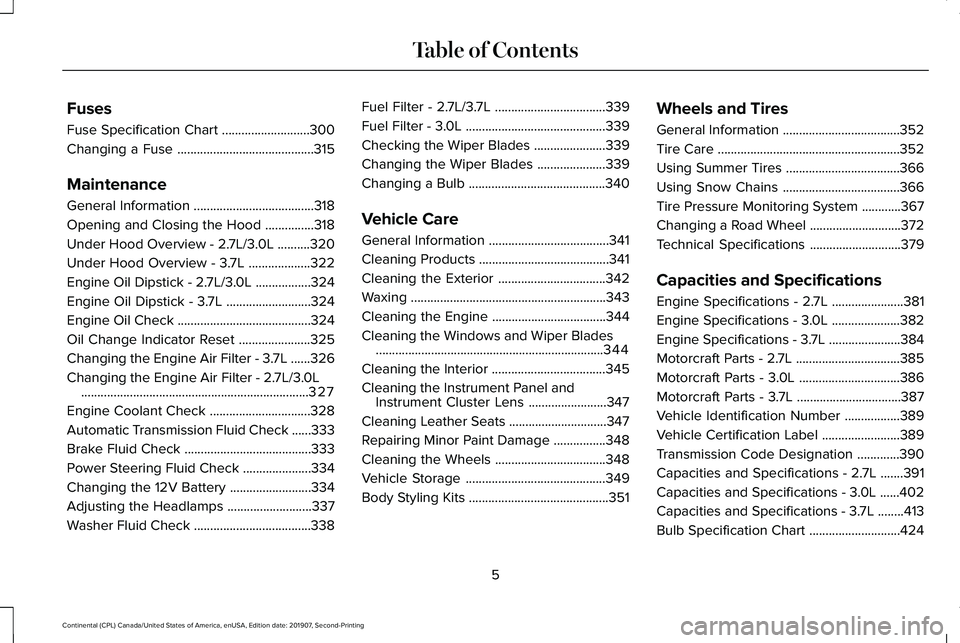
Fuses
Fuse Specification Chart
...........................300
Changing a Fuse ..........................................
315
Maintenance
General Information .....................................
318
Opening and Closing the Hood ...............
318
Under Hood Overview - 2.7L/3.0L ..........
320
Under Hood Overview - 3.7L ...................
322
Engine Oil Dipstick - 2.7L/3.0L .................
324
Engine Oil Dipstick - 3.7L ..........................
324
Engine Oil Check .........................................
324
Oil Change Indicator Reset ......................
325
Changing the Engine Air Filter - 3.7L ......
326
Changing the Engine Air Filter - 2.7L/3.0L ......................................................................
327
Engine Coolant Check ...............................
328
Automatic Transmission Fluid Check ......
333
Brake Fluid Check .......................................
333
Power Steering Fluid Check .....................
334
Changing the 12V Battery .........................
334
Adjusting the Headlamps ..........................
337
Washer Fluid Check ....................................
338Fuel Filter - 2.7L/3.7L
..................................
339
Fuel Filter - 3.0L ...........................................
339
Checking the Wiper Blades ......................
339
Changing the Wiper Blades .....................
339
Changing a Bulb ..........................................
340
Vehicle Care
General Information .....................................
341
Cleaning Products ........................................
341
Cleaning the Exterior .................................
342
Waxing ............................................................
343
Cleaning the Engine ...................................
344
Cleaning the Windows and Wiper Blades ......................................................................
344
Cleaning the Interior ...................................
345
Cleaning the Instrument Panel and Instrument Cluster Lens ........................
347
Cleaning Leather Seats ..............................
347
Repairing Minor Paint Damage ................
348
Cleaning the Wheels ..................................
348
Vehicle Storage ...........................................
349
Body Styling Kits ...........................................
351Wheels and Tires
General Information
....................................
352
Tire Care ........................................................
352
Using Summer Tires ...................................
366
Using Snow Chains ....................................
366
Tire Pressure Monitoring System ............
367
Changing a Road Wheel ............................
372
Technical Specifications ............................
379
Capacities and Specifications
Engine Specifications - 2.7L ......................
381
Engine Specifications - 3.0L .....................
382
Engine Specifications - 3.7L ......................
384
Motorcraft Parts - 2.7L ................................
385
Motorcraft Parts - 3.0L ...............................
386
Motorcraft Parts - 3.7L ................................
387
Vehicle Identification Number .................
389
Vehicle Certification Label ........................
389
Transmission Code Designation .............
390
Capacities and Specifications - 2.7L .......
391
Capacities and Specifications - 3.0L ......
402
Capacities and Specifications - 3.7L ........
413
Bulb Specification Chart ............................
424
5
Continental (CPL) Canada/United States of America, enUSA, Edition date: 201907, Second-Printing Table of Contents
Page 11 of 609
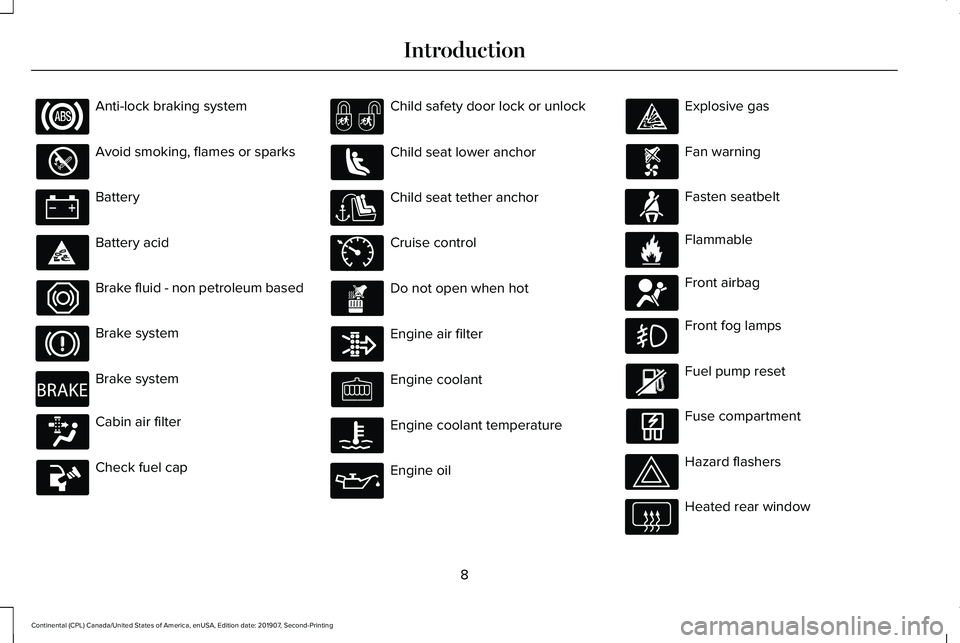
Anti-lock braking system
Avoid smoking, flames or sparks
Battery
Battery acid
Brake fluid - non petroleum based
Brake system
Brake system
Cabin air filter
Check fuel cap Child safety door lock or unlock
Child seat lower anchor
Child seat tether anchor
Cruise control
Do not open when hot
Engine air filter
Engine coolant
Engine coolant temperature
Engine oil Explosive gas
Fan warning
Fasten seatbelt
Flammable
Front airbag
Front fog lamps
Fuel pump reset
Fuse compartment
Hazard flashers
Heated rear window
8
Continental (CPL) Canada/United States of America, enUSA, Edition date: 201907, Second-Printing Introduction E270480 E71340 E71880 E231160 E67017
Page 13 of 609
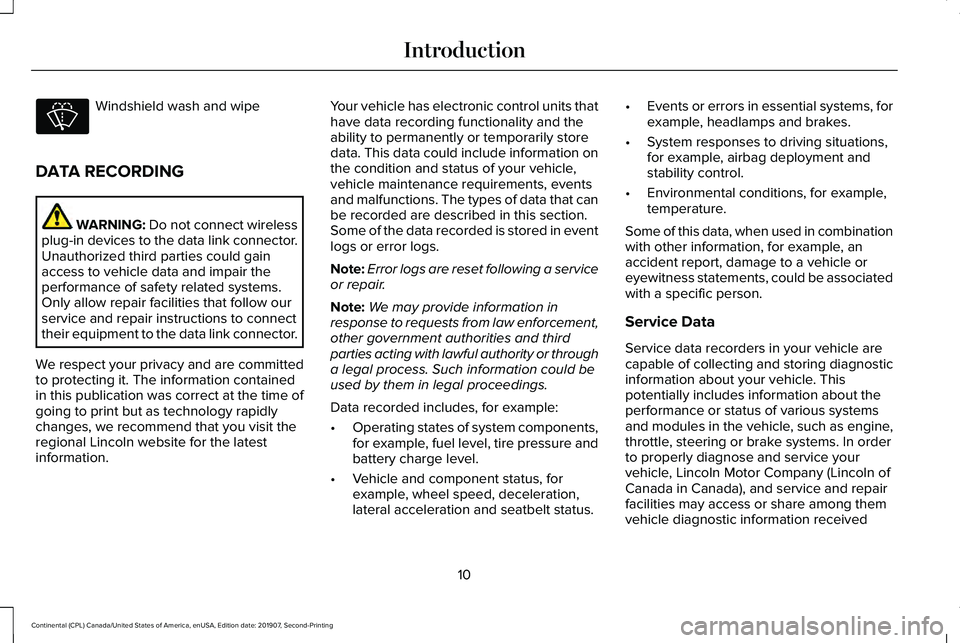
Windshield wash and wipe
DATA RECORDING WARNING: Do not connect wireless
plug-in devices to the data link connector.
Unauthorized third parties could gain
access to vehicle data and impair the
performance of safety related systems.
Only allow repair facilities that follow our
service and repair instructions to connect
their equipment to the data link connector.
We respect your privacy and are committed
to protecting it. The information contained
in this publication was correct at the time of
going to print but as technology rapidly
changes, we recommend that you visit the
regional Lincoln website for the latest
information. Your vehicle has electronic control units that
have data recording functionality and the
ability to permanently or temporarily store
data. This data could include information on
the condition and status of your vehicle,
vehicle maintenance requirements, events
and malfunctions. The types of data that can
be recorded are described in this section.
Some of the data recorded is stored in event
logs or error logs.
Note:
Error logs are reset following a service
or repair.
Note: We may provide information in
response to requests from law enforcement,
other government authorities and third
parties acting with lawful authority or through
a legal process. Such information could be
used by them in legal proceedings.
Data recorded includes, for example:
• Operating states of system components,
for example, fuel level, tire pressure and
battery charge level.
• Vehicle and component status, for
example, wheel speed, deceleration,
lateral acceleration and seatbelt status. •
Events or errors in essential systems, for
example, headlamps and brakes.
• System responses to driving situations,
for example, airbag deployment and
stability control.
• Environmental conditions, for example,
temperature.
Some of this data, when used in combination
with other information, for example, an
accident report, damage to a vehicle or
eyewitness statements, could be associated
with a specific person.
Service Data
Service data recorders in your vehicle are
capable of collecting and storing diagnostic
information about your vehicle. This
potentially includes information about the
performance or status of various systems
and modules in the vehicle, such as engine,
throttle, steering or brake systems. In order
to properly diagnose and service your
vehicle, Lincoln Motor Company (Lincoln of
Canada in Canada), and service and repair
facilities may access or share among them
vehicle diagnostic information received
10
Continental (CPL) Canada/United States of America, enUSA, Edition date: 201907, Second-Printing Introduction
Page 17 of 609

The cell phone profile, media device index
and diagnostic log remain in your vehicle
unless you delete them and are generally
accessible only in your vehicle when you
connect your cell phone or media device. If
you no longer plan to use the system or your
vehicle, we recommend you use the master
reset function to erase the stored
information. See Settings (page 486).
System data cannot be accessed without
special equipment and access to your
vehicle's module.
For additional information about our privacy
policy, refer to your local Lincoln website.
Note: To find out if your vehicle has a
connectivity technology, visit
www .ConnectedLincoln. com .
Vehicles With an Emergency Call
System
When the emergency call system is active,
it may disclose to emergency services that
your vehicle has been in a crash involving
the deployment of an airbag or activation of
the fuel pump shut-off. Certain versions or
updates to the emergency call system may also be capable of electronically or verbally
disclosing to emergency services operators
your vehicle location or other details about
your vehicle or crash to assist emergency
services operators to provide the most
appropriate emergency services. If you do
not want to disclose this information, do not
activate the emergency call system.
Note:
You cannot deactivate emergency call
systems that are required by law.
PERCHLORATE
Certain components in your vehicle such as
airbag modules, seatbelt pretensioners and
remote control batteries may contain
perchlorate material. Special handling may
apply for service or vehicle end of life
disposal. For more information visit: Web Address
www.dtsc.ca.gov/hazard- ouswaste/perchlorate
LINCOLN AUTOMOTIVE
FINANCIAL SERVICES
Lincoln Automotive Financial Services offers
a full range of financing and lease plans to
help you acquire your vehicle. We are
dedicated to providing answers, information
and a truly extraordinary experience.
Use the options below to contact us with
questions about your account or financing
and we will respond promptly: Web Address
www.credit.lincoln.com
Phone: 1-888-498-8801
Mail: Lincoln Automotive Financial Services
14
Continental (CPL) Canada/United States of America, enUSA, Edition date: 201907, Second-Printing Introduction
Page 62 of 609
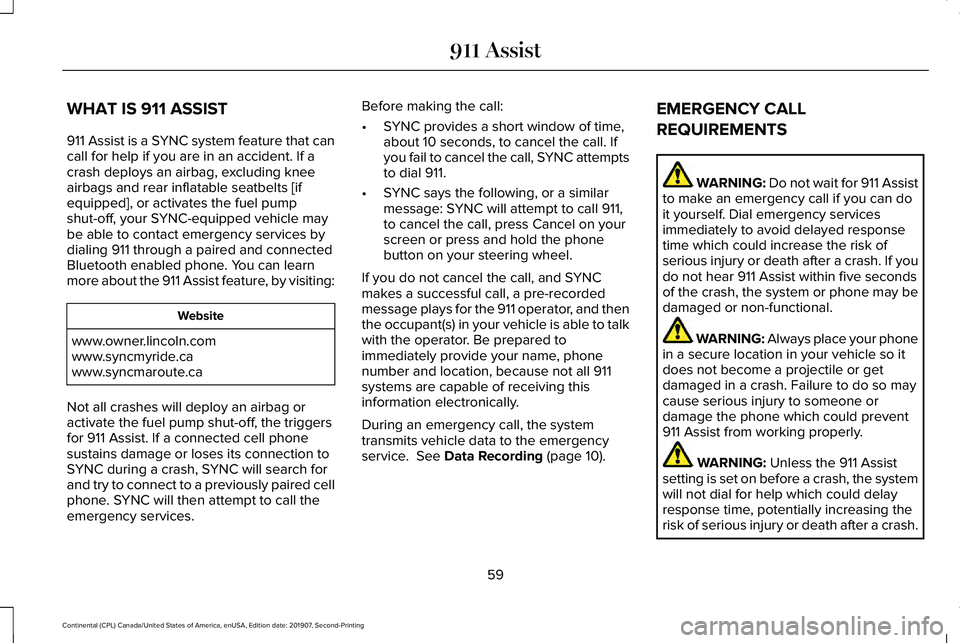
WHAT IS 911 ASSIST
911 Assist is a SYNC system feature that can
call for help if you are in an accident. If a
crash deploys an airbag, excluding knee
airbags and rear inflatable seatbelts [if
equipped], or activates the fuel pump
shut-off, your SYNC-equipped vehicle may
be able to contact emergency services by
dialing 911 through a paired and connected
Bluetooth enabled phone. You can learn
more about the 911 Assist feature, by visiting:
Website
www.owner.lincoln.com
www.syncmyride.ca
www.syncmaroute.ca
Not all crashes will deploy an airbag or
activate the fuel pump shut-off, the triggers
for 911 Assist. If a connected cell phone
sustains damage or loses its connection to
SYNC during a crash, SYNC will search for
and try to connect to a previously paired cell
phone. SYNC will then attempt to call the
emergency services. Before making the call:
•
SYNC provides a short window of time,
about 10 seconds, to cancel the call. If
you fail to cancel the call, SYNC attempts
to dial 911.
• SYNC says the following, or a similar
message: SYNC will attempt to call 911,
to cancel the call, press Cancel on your
screen or press and hold the phone
button on your steering wheel.
If you do not cancel the call, and SYNC
makes a successful call, a pre-recorded
message plays for the 911 operator, and then
the occupant(s) in your vehicle is able to talk
with the operator. Be prepared to
immediately provide your name, phone
number and location, because not all 911
systems are capable of receiving this
information electronically.
During an emergency call, the system
transmits vehicle data to the emergency
service. See Data Recording (page 10). EMERGENCY CALL
REQUIREMENTS WARNING: Do not wait for 911 Assist
to make an emergency call if you can do
it yourself. Dial emergency services
immediately to avoid delayed response
time which could increase the risk of
serious injury or death after a crash. If you
do not hear 911 Assist within five seconds
of the crash, the system or phone may be
damaged or non-functional. WARNING: Always place your phone
in a secure location in your vehicle so it
does not become a projectile or get
damaged in a crash. Failure to do so may
cause serious injury to someone or
damage the phone which could prevent
911 Assist from working properly. WARNING: Unless the 911 Assist
setting is set on before a crash, the system
will not dial for help which could delay
response time, potentially increasing the
risk of serious injury or death after a crash.
59
Continental (CPL) Canada/United States of America, enUSA, Edition date: 201907, Second-Printing 911 Assist
Page 67 of 609
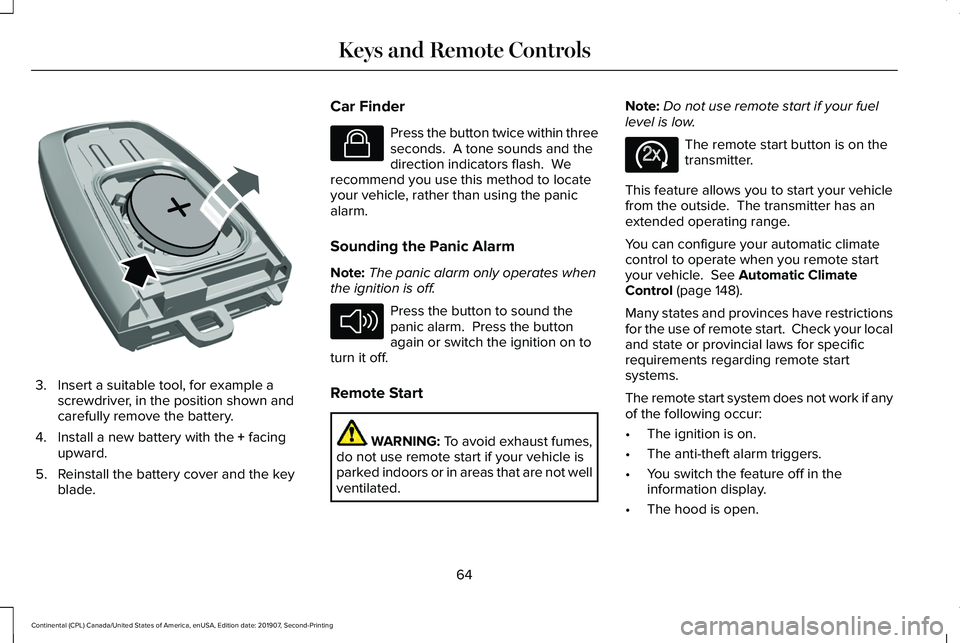
3. Insert a suitable tool, for example a
screwdriver, in the position shown and
carefully remove the battery.
4. Install a new battery with the + facing
upward.
5. Reinstall the battery cover and the key blade. Car Finder Press the button twice within three
seconds. A tone sounds and the
direction indicators flash. We
recommend you use this method to locate
your vehicle, rather than using the panic
alarm.
Sounding the Panic Alarm
Note: The panic alarm only operates when
the ignition is off. Press the button to sound the
panic alarm. Press the button
again or switch the ignition on to
turn it off.
Remote Start WARNING: To avoid exhaust fumes,
do not use remote start if your vehicle is
parked indoors or in areas that are not well
ventilated. Note:
Do not use remote start if your fuel
level is low. The remote start button is on the
transmitter.
This feature allows you to start your vehicle
from the outside. The transmitter has an
extended operating range.
You can configure your automatic climate
control to operate when you remote start
your vehicle.
See Automatic Climate
Control (page 148).
Many states and provinces have restrictions
for the use of remote start. Check your local
and state or provincial laws for specific
requirements regarding remote start
systems.
The remote start system does not work if any
of the following occur:
• The ignition is on.
• The anti-theft alarm triggers.
• You switch the feature off in the
information display.
• The hood is open.
64
Continental (CPL) Canada/United States of America, enUSA, Edition date: 201907, Second-Printing Keys and Remote ControlsE218402 E138623 E138624 E138625
Page 70 of 609
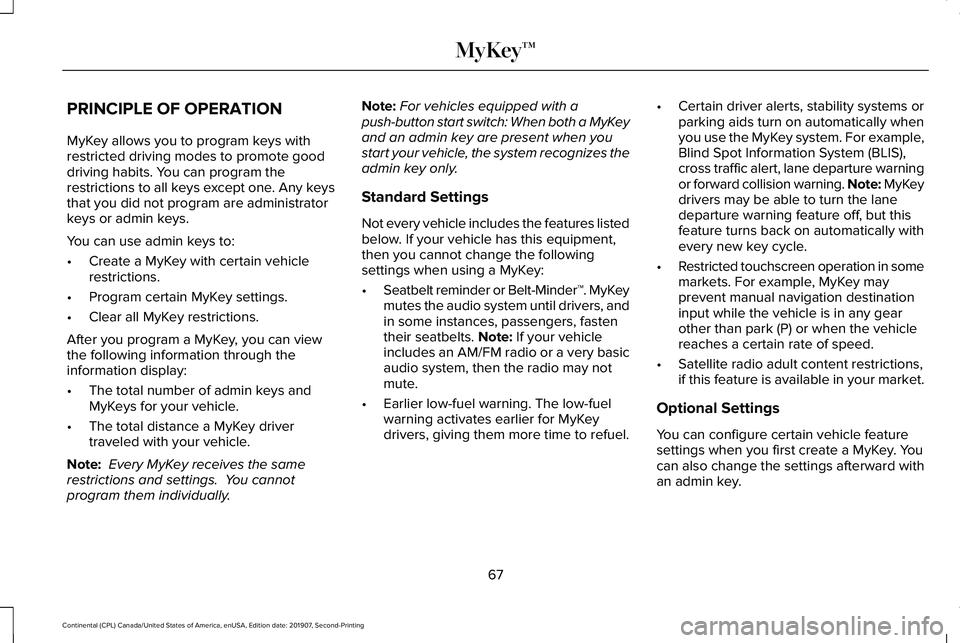
PRINCIPLE OF OPERATION
MyKey allows you to program keys with
restricted driving modes to promote good
driving habits. You can program the
restrictions to all keys except one. Any keys
that you did not program are administrator
keys or admin keys.
You can use admin keys to:
•
Create a MyKey with certain vehicle
restrictions.
• Program certain MyKey settings.
• Clear all MyKey restrictions.
After you program a MyKey, you can view
the following information through the
information display:
• The total number of admin keys and
MyKeys for your vehicle.
• The total distance a MyKey driver
traveled with your vehicle.
Note: Every MyKey receives the same
restrictions and settings. You cannot
program them individually. Note:
For vehicles equipped with a
push-button start switch: When both a MyKey
and an admin key are present when you
start your vehicle, the system recognizes the
admin key only.
Standard Settings
Not every vehicle includes the features listed
below. If your vehicle has this equipment,
then you cannot change the following
settings when using a MyKey:
• Seatbelt reminder or Belt-Minder™. MyKey
mutes the audio system until drivers, and
in some instances, passengers, fasten
their seatbelts. Note: If your vehicle
includes an AM/FM radio or a very basic
audio system, then the radio may not
mute.
• Earlier low-fuel warning. The low-fuel
warning activates earlier for MyKey
drivers, giving them more time to refuel. •
Certain driver alerts, stability systems or
parking aids turn on automatically when
you use the MyKey system. For example,
Blind Spot Information System (BLIS),
cross traffic alert, lane departure warning
or forward collision warning. Note: MyKey
drivers may be able to turn the lane
departure warning feature off, but this
feature turns back on automatically with
every new key cycle.
• Restricted touchscreen operation in some
markets. For example, MyKey may
prevent manual navigation destination
input while the vehicle is in any gear
other than park (P) or when the vehicle
reaches a certain rate of speed.
• Satellite radio adult content restrictions,
if this feature is available in your market.
Optional Settings
You can configure certain vehicle feature
settings when you first create a MyKey. You
can also change the settings afterward with
an admin key.
67
Continental (CPL) Canada/United States of America, enUSA, Edition date: 201907, Second-Printing MyKey™
Page 75 of 609

LOCKING AND UNLOCKING
Your vehicle has an intelligent electronically
controlled door system that is in constant
communication with overall vehicle systems.
When you lock your vehicle using the lock
switch on each door interior trim panel, or
by using the keyless entry keypad or the lock
sensor on each door exterior trim panel, the
exterior door handle switches do not release
the doors. This helps to secure your vehicle
and prevent unauthorized entry. Also, when
your vehicle reaches a speed greater than
12 mph (20 km/h), the exterior door handle
switches do not release the doors.
If the airbags deploy or the fuel pump shutoff
switch activates, all interior and exterior
unlock switches do not unlock your door for
six seconds. This helps to secure the doors
in the event of a crash. After six seconds all
switches reset, and you can open the doors
using the interior and exterior unlatch
switches. Door Lock Indicator
An LED on each front door window trim
illuminates when you lock the doors. It
remains on for two to five seconds after you
switch the ignition off.
Door Lock Switch Inhibitor
When you electronically lock your vehicle,
the door lock switches and the interior
luggage compartment release switch do not
operate after 20 seconds. You must unlock
your vehicle with the remote control or
keyless entry keypad, or switch the ignition
on, to restore function to these switches.
You can switch this feature on or off using
the information display controls.
See
General Information (page 117).
Activating Intelligent Access
The intelligent access key must be within 3 ft
(1 m)
of the door or luggage compartment
you intend to lock or unlock. At a Door
72
Continental (CPL) Canada/United States of America, enUSA, Edition date: 201907, Second-Printing Doors and LocksE222428